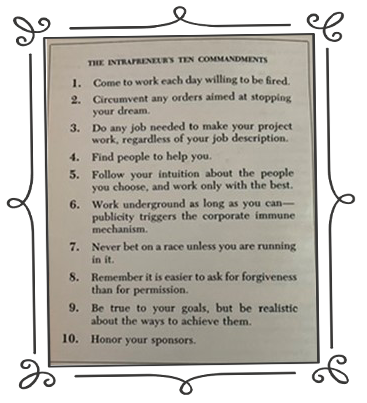As I was thinking about writing on the topic of self-organizing teams, I ran a Google search to see what popped up. All the top-level results were references from agile sites like scrum.org. That would lead one to believe that the concept of self-organizing teams is new, something that was somehow invented along with agile approaches.
I disagree with that. I think that truly high-performing teams have historically been self-organizing. The challenge is that both the team and their management must change their mindset for it to work effectively.
I’ve been fortunate to work on both sides of that equation – first as an individual on a self-organizing team, and then as a manager. I’d like to share some lessons learned. In this article I’ll focus on things I’ve learned as an individual contributor; I’ll follow that up with thoughts for managers in another article.
Team members must think differently about their role.
I was blessed to have a wonderful mentor during my first job after college. Herb and I are still in touch and I still value his counsel. If you take nothing else away from this article, take this piece of advice: Find a mentor. They can be invaluable.
Herb had me read a book that still sits on my bookshelf: Intranpreneuring: Why You Don’t Have to Leave the Corporation to Become an Entrepreneur. The philosophies in this book helped form the foundation of my approach to work, first as a team member, and then as a manager. A copy of this page from the book hung in my office for most of my career:

Admittedly, some of these are pretty extreme. You may also feel like you can’t necessarily control all these things. But let’s put a 2024 self-managing team spin on my 1985 rules.
Rule #1
Come to work each day willing to be fired.
Yeah, that’s one of the extreme ones. I’m truly not going to advocate that you put yourself in a position to get fired.
Having said that, you should be willing to practice “intelligent disobedience”. If you feel like your team is heading in the wrong direction, take responsibility for calling that out. Objectively lay out your concerns and offer alternatives. There’s not a lot of room for “sheeple” on self-organizing teams.
Rule #2
Circumvent any orders aimed at stopping your dream.
Ok, ok…this one also sounds extreme. Let’s look at it with a slightly different lens:
- Dream big! Think outside the box!
- Take time to learn and experiment in pursuit of those big ideas
- Learn from your failures
Don’t let fear of failure stop you from trying new ideas and new approaches. They won’t all work… but some of them just might. And one of those might just be the next big idea for your team or organization.
Rule #3
Do any job needed to make your project work, regardless of your job description.
If you’ve spent any time researching self-organizing teams, this rule won’t come as any surprise. It’s at the heart of how these teams succeed. It’s not your work or my work or Fred’s work… it’s the team’s work. We all do whatever we need to do in order to reach our goal.
Rule #4
Find people to help you.
How many of you will admit that you’ve run into a problem and hesitated to ask for help? I’ve been there more times than I’d like to admit. Transparency and interdependence are key ingredients for self-organizing teams. Don’t keep beating your head on the wall, and don’t hide the problem hoping it’ll go away. It probably won’t.
Rule #5
Follow your intuition about the people you choose, and work with only the best.
This rule may seem a little challenging for individual team members. After all, you generally don’t get to pick your team, do you? Well, even if that’s the case, most of us have networks that extend beyond our formal team. Seek out and build relationships with other individuals who can help you learn and grow.
Return the favor, too – be available to others in your organization who may benefit from what you know. Maybe someday you can be somebody’s “Herb”.
Rule #6
Work underground as long as you can – publicity triggers the corporate immune mechanism.
On the surface, Rule #6 can sound a little…devious? Dishonest? Let’s reframe it a bit.
Think back to Rule #2, where we talked about trying new things. In my mind, Rule #6 isn’t asking you to hide those new things from your organization. It’s encouraging you to wait until they’re more fully formed before you bring them forward for consideration. You’re much more likely to get a positive response to a new idea if you’ve taken the time to flesh it out a bit. Otherwise, the “corporate immune mechanism” may kick in and squash it before it’s had a chance to mature.
Rule #7
Never bet on a race unless you are running in it.
My version of this for self-organizing teams: Never let someone else tell you how to do the work or what it’s going to take to get it done.
If you’ve been handed an unrealistic deadline… speak up. If there’s a better way to accomplish a goal… propose it. If you need more or different resources… ask for them. This is another great opportunity to practice the “intelligent disobedience” we discussed in Rule #1.
Rule #8
Remember it is easier to ask for forgiveness than for permission.
As a manager, I struggle when subordinates check with me for every little thing. I want – and need – people on my team to make decisions and take responsibility for their own work. I have plenty of my own work to do, thank you very much.
What this means is that I expect my team members to make the best decisions they can within the boundaries of authority we’ve jointly set without coming to me for confirmation every time. Next time you’ve got a decision to make, think about who really needs to be involved in that decision. Can you make the decision? Can the team? Or is it truly something that needs management input? As you consider those questions, remember the earlier points we’ve made about learning from mistakes. That principle can apply here, too.
Rule #9
Be true to your goals, but be realistic about the ways to achieve them.
When we set out to accomplish a goal, we often have grand visions of what success looks like. However, we’re also frequently asked to define a “minimum” vision. You’ve probably heard several versions of this: Minimum viable product, minimum valuable product, minimum marketable product, minimum lovable product… these all speak to the same concept.
As a team, we have a mission, but we have to be realistic about what we can accomplish with the time and the resources we have. We can be key players in defining what success truly looks like, and in ensuring that we deliver the most value possible for our stakeholders.
Rule #10
Honor your sponsors.
If your leadership is following the management mantras I’m outlining in Part 2 of this blog post, they’ll take the heat when you make a mistake. Be respectful of that, and don’t put them in that position routinely or thoughtlessly.
Also, remember to acknowledge and appreciate the contributions of your leadership team. I can attest to the fact that the good ones are out there every day, fighting the good fight so their teams can have what they need to succeed. A little appreciation goes a long way.
Some 40-year old advice is still good!
What’s old is new again! I think the concept of self-organizing teams is an example of that. I’ve had the privilege of working on and with them for most of my career.
Successful self-organizing teams do need one other key ingredient: understanding and supportive leadership. In Part 2 of this blog post, I share my 6 Mantras for Managing Self-Organizing Teams and outline leadership behaviors that are needed if self-organizing teams are going to be successful.
I hope you’ll consider some of the rules I’ve reviewed. They’ve served me well for almost four decades. Let me know how they work for you!
–Kathy

Kathy Claycomb
Managing Partner, Lead Expert
Kathy Claycomb brings over 35 years of experience to the classroom. She has participated in all phases of solution development using everything from agile to waterfall methodologies (and quite a few in between). Before joining B2T, her career spanned roles from application developer to Senior Director of Services at various organizations. Kathy has broad industry background including transportation, manufacturing, insurance, energy, healthcare, and banking.
Kathy’s first love is teaching, and throughout her career she has always managed to spend a portion of her time instructing. She has an engaging, highly interactive teaching style that ensures students leave the course with a thorough grasp of the material. Her students consistently praise her teaching abilities and her talent for drawing on her personal experience to enhance their learning.
Kathy served as the Technical Editor for Business Analysis for Dummies, 2nd Edition.




